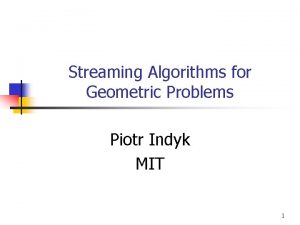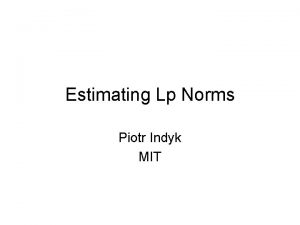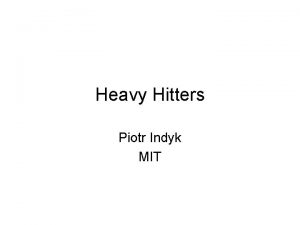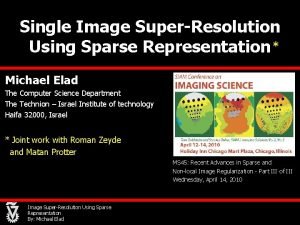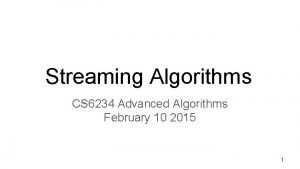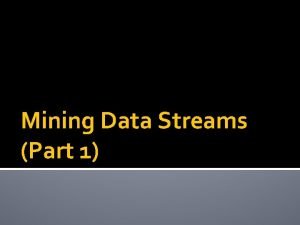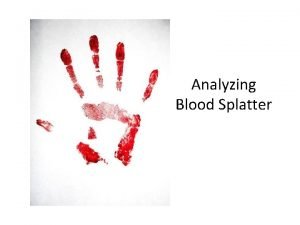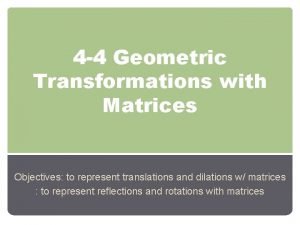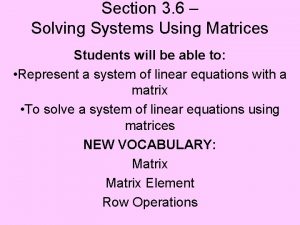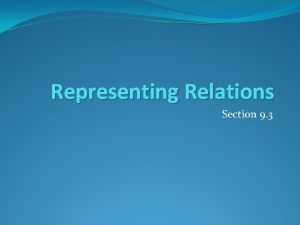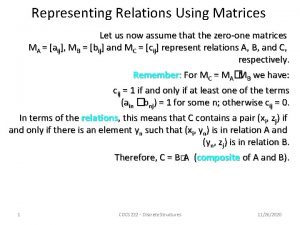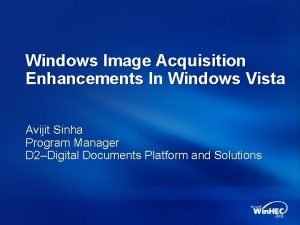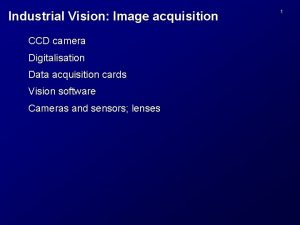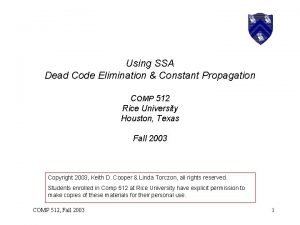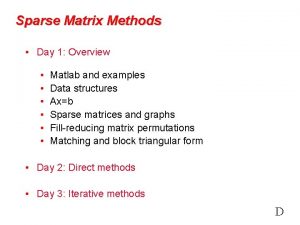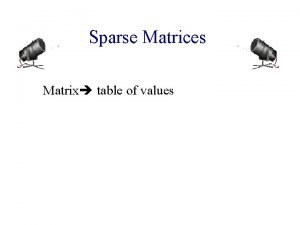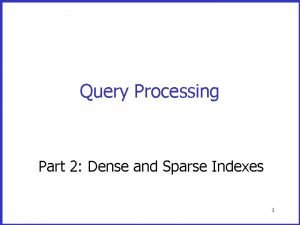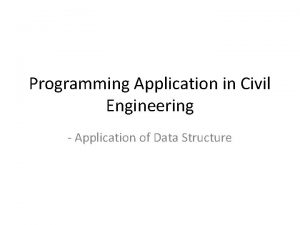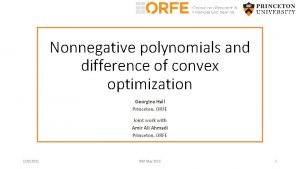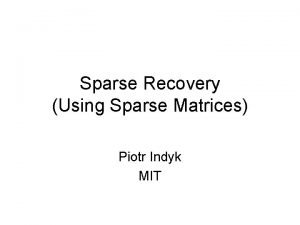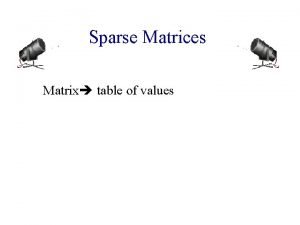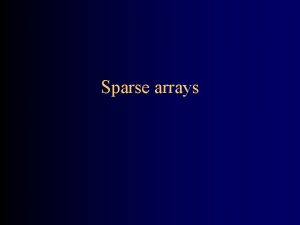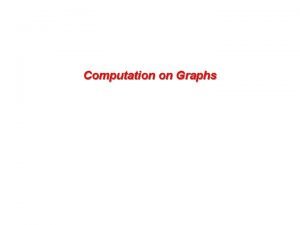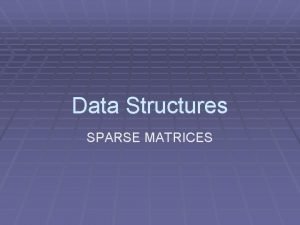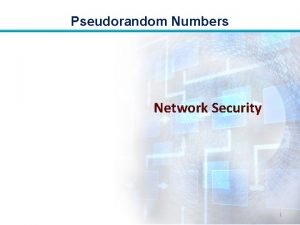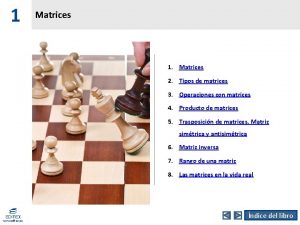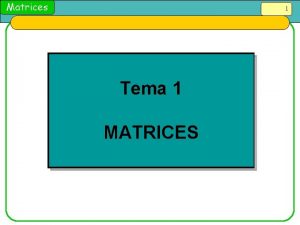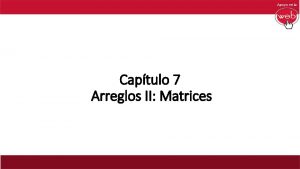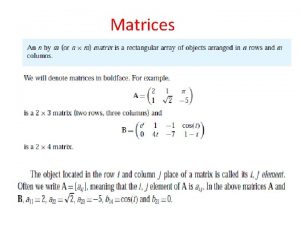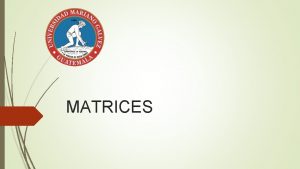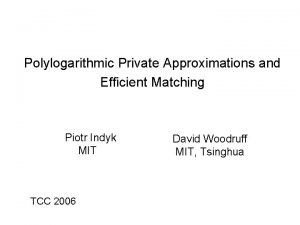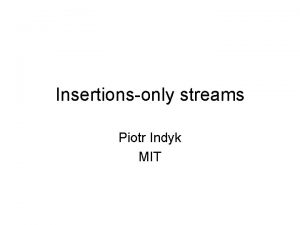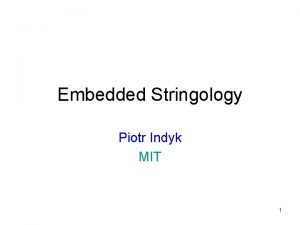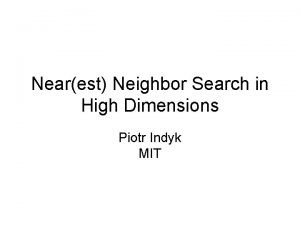Image acquisition using sparse pseudorandom matrices Piotr Indyk




![Algorithms for Sparse Matrices • Sketching/streaming [Charikar-Chen-Colton’ 02, Estan-Varghese’ 03, Cormode -Muthukrishnan’ 04] • Algorithms for Sparse Matrices • Sketching/streaming [Charikar-Chen-Colton’ 02, Estan-Varghese’ 03, Cormode -Muthukrishnan’ 04] •](https://slidetodoc.com/presentation_image_h/1311aaabba8a4b24f350c70a962a0c93/image-5.jpg)
![dense vs. sparse • • Restricted Isometry Property (RIP) [Candes-Tao’ 04] is k-sparse || dense vs. sparse • • Restricted Isometry Property (RIP) [Candes-Tao’ 04] is k-sparse ||](https://slidetodoc.com/presentation_image_h/1311aaabba8a4b24f350c70a962a0c93/image-6.jpg)
![Experiments [Berinde-Indyk’ 09] 256 x 256 SSMP is ran with S=10000, T=20. SMP is Experiments [Berinde-Indyk’ 09] 256 x 256 SSMP is ran with S=10000, T=20. SMP is](https://slidetodoc.com/presentation_image_h/1311aaabba8a4b24f350c70a962a0c93/image-7.jpg)



















- Slides: 26

Image acquisition using sparse (pseudo)-random matrices Piotr Indyk MIT

Outline • Sparse recovery using sparse random matrices • Using sparse matrices for image acquisition

Sparse recovery (approximation theory, statistical model selection, information-based complexity, learning Fourier coeffs, linear sketching, finite rate of innovation, compressed sensing. . . ) • Setup: • – Data/signal in n-dimensional space : x – Goal: compress x into a “sketch” or “measurement” Ax , where A is a m x n matrix, m << n Stable recovery: want to recover an “approximation” x* of x A – Sparsity parameter k – Informally: want to recover largest k coordinates of x – Formally: lp/lq guarantee. I. e. want x* such that ||x*-x||p C(k) minx’ ||x’-x||q • over all x’ that are k-sparse (at most k non-zero entries) Want: – Good compression (small m=m(k, n)) – Efficient algorithms for encoding and recovery • Useful for compressed sensing of signals, data stream algorithms, genetic experiment pooling etc…. x = Ax

Constructing matrix A • “Most” matrices A work – Dense matrices: • Compressed sensing – Sparse matrices: • Streaming algorithms • Coding theory (LDPC) • “Traditional” tradeoffs: – Sparse: computationally more efficient, explicit – Dense: shorter sketches, i. e. k log(n/k) [Candes-Romberg-Tao’ 04] • Recent results: efficient and measurement-optimal
![Algorithms for Sparse Matrices Sketchingstreaming CharikarChenColton 02 EstanVarghese 03 Cormode Muthukrishnan 04 Algorithms for Sparse Matrices • Sketching/streaming [Charikar-Chen-Colton’ 02, Estan-Varghese’ 03, Cormode -Muthukrishnan’ 04] •](https://slidetodoc.com/presentation_image_h/1311aaabba8a4b24f350c70a962a0c93/image-5.jpg)
Algorithms for Sparse Matrices • Sketching/streaming [Charikar-Chen-Colton’ 02, Estan-Varghese’ 03, Cormode -Muthukrishnan’ 04] • LDPC-like: [Xu-Hassibi’ 07, Indyk’ 08, Jafarpour-Xu-Hassibi-Calderbank’ 08] • L 1 minimization: [Berinde-Gilbert-Indyk-Karloff-Strauss’ 08, Wang • • Wainwright-Ramchandran’ 08] Message passing: [Sarvotham-Baron-Baraniuk’ 06, ’ 08, Lu-Montanari- Prabhakar’ 08, Akcakaya-Tarokh’ 11] Matching pursuit*: [Indyk-Ruzic’ 08, Berinde-Indyk-Ruzic’ 08, Berinde. Indyk’ 09, Gilbert-Lu-Porat-Strauss’ 10] • Surveys: – A. Gilbert, P. Indyk, Proceedings of IEEE, June 2010 – V. Cevher, P. Indyk, L. Carin, and R. Baraniuk. IEEE Signal Processing Magazine, 26, 2010. * Near-linear time (or better), O(k log(n/k)) , stable recovery (l 1/l 1 guarantee)
![dense vs sparse Restricted Isometry Property RIP CandesTao 04 is ksparse dense vs. sparse • • Restricted Isometry Property (RIP) [Candes-Tao’ 04] is k-sparse ||](https://slidetodoc.com/presentation_image_h/1311aaabba8a4b24f350c70a962a0c93/image-6.jpg)
dense vs. sparse • • Restricted Isometry Property (RIP) [Candes-Tao’ 04] is k-sparse || ||2 ||A ||2 C || ||2 Holds w. h. p. for: N(S) – Random Gaussian/Bernoulli: m=O(k log (n/k)) – Random Fourier: m=O(k log. O(1) n) • • • Consider m x n 0 -1 matrices with d ones per column Do they satisfy RIP ? – No, unless m= (k 2) [Chandar’ 07] However, they can satisfy the following RIP-1 property d S m [Berinde-Gilbert-Indyk-Karloff-Strauss’ 08]: is k-sparse d (1 - ) || ||1 ||A ||1 d|| ||1 • Sufficient (and necessary) condition: the underlying graph is a ( k, d(1 - /2) )-expander (a random matrix with d=k log (n/k) and m=O(k log (n/k)/ ^2) is good w. h. p) n
![Experiments BerindeIndyk 09 256 x 256 SSMP is ran with S10000 T20 SMP is Experiments [Berinde-Indyk’ 09] 256 x 256 SSMP is ran with S=10000, T=20. SMP is](https://slidetodoc.com/presentation_image_h/1311aaabba8a4b24f350c70a962a0c93/image-7.jpg)
Experiments [Berinde-Indyk’ 09] 256 x 256 SSMP is ran with S=10000, T=20. SMP is ran for 100 iterations. Matrix sparsity is d=8.

Random sparse matrices for image acquisition • Implementable using random lens approach [R. Fergus, A. Torralba, W. T. Freeman’ 06] – Random design tricky to deal with • Alternative: make random matrices less random using “folding” [Gupta-Indyk-Price. Rachlin’ 11]

Folding 1 1 1 1 1 1 1 1

Architectures • Optically multiplexed imaging – Replicate d times – Split the beam • CMOS [Uttam-Goodman-Neifeld. Kim-John-Kim-Brady’ 09]

Application: star tracking

Application: star tracking • Star tracker – Find some/most stars – Lookup the database • Images are sparse compressive star tracker

How do we recover from folded measurements ? • Option I: generic approach – Use any algorithm to recover (most of) the stars (if needed, “pretend” the matrix is random) – Lookup the database • Option II: Algorithm tailored to folded measurements of “geometric objects” – O(k logkn) measurements and similar recovery time (under some assumptions) – Uses O(logkn) folds

Results

Conclusions • Sparse recovery using sparse matrices • Natural architectures

APPENDIX

References • Survey: A. Gilbert, P. Indyk, “Sparse recovery using sparse matrices”, Proceedings of IEEE, June 2010. • Courses: – “Streaming, sketching, and sub-linear space algorithms”, Fall’ 07 – “Sub-linear algorithms” (with Ronitt Rubinfeld), Fall’ 10 • Blogs: – Nuit blanche: nuit-blanche. blogspot. com/

Appendix

Application I: Monitoring Network Traffic Data Streams • Router routs packets – Where do they come from ? – Where do they go to ? • Ideally, would like to maintain a traffic matrix x[. , . ] • Using linear compression we can: – Maintain sketch Ax under increments to x, since A(x+ ) = Ax + A – Recover x* from Ax destination source – Easy to update: given a (src, dst) packet, increment xsrc, dst – Requires way too much space! (232 x 232 entries) – Need to compress x, increment easily x

l∞/l 1 implies l 1/l 1 • Algorithm: – Assume we have x* s. t. ||x-x*||∞≤ C Err 1 /k. – Let vector x’ consist of k largest (in magnitude) elements of x* • Analysis – Let S (or S* ) be the set of k largest in magnitude coordinates of x (or x* ) – Note that ||x*S|| ≤ ||x*S*||1 – We have ||x-x’||1 ≤ ||x||1 - ||x. S*||1 + ||x. S*-x*S*||1 ≤ ||x||1 - ||x*S*||1 + 2||x. S*-x*S*||1 ≤ ||x||1 - ||x*S||1 + 2||x. S*-x*S*||1 ≤ ||x||1 - ||x. S||1 + ||x*S-x. S||1 + 2||x. S*-x*S*||1 ≤ Err + 3 /k * k ≤ (1+3 )Err

Application I: Monitoring Network Traffic Data Streams • Router routs packets – Where do they come from ? – Where do they go to ? • Ideally, would like to maintain a traffic matrix x[. , . ] • Using linear compression we can: – Maintain sketch Ax under increments to x, since A(x+ ) = Ax + A – Recover x* from Ax destination source – Easy to update: given a (src, dst) packet, increment xsrc, dst – Requires way too much space! (232 x 232 entries) – Need to compress x, increment easily x

Applications, ctd. • Single pixel camera [Wakin, Laska, Duarte, Baron, Sarvotham, Takhar, Kelly, Baraniuk’ 06] • Pooling Experiments [Kainkaryam, Woolf’ 08], [Hassibi et al’ 07], [Dai. Sheikh, Milenkovic, Baraniuk], [Shental-Amir. Zuk’ 09], [Erlich-Shental-Amir-Zuk’ 09]

Experiments 256 x 256 SSMP is ran with S=10000, T=20. SMP is ran for 100 iterations. Matrix sparsity is d=8.

SSMP: Running time • Algorithm: – x*=0 – Repeat T times • For each i=1…n compute* zi that achieves A Di=minz ||A(x*+zei)-b||1 and store Di in a heap • Repeat S=O(k) times i – Pick i, z that yield the best gain – Update x* = x*+zei – Recompute and store Di’ for all i’ such that N(i) and N(i’) intersect • Sparsify x* (set all but k largest entries of x* to 0) • Running time: T [ n(d+log n) + k nd/m*d (d+log n)] = T [ n(d+log n) + nd (d+log n)] = T [ nd (d+log n)] Ax-Ax* x-x*

Prior and New Results Paper Rand. / Det. Sketch length Encode time Column sparsity Recovery time Approx

Scale: Excellent Very Good Fair Results Paper R/ D Sketch length Encode time Column sparsity Recovery time Approx [CCF’ 02], [CM’ 06] R k log n n log n l 2 / l 2 R k logc n n logc n k logc n l 2 / l 2 [CM’ 04] R k log n n log n l 1 / l 1 R k logc n n logc n k logc n l 1 / l 1 [CRT’ 04] [RV’ 05] D k log(n/k) nk log(n/k) nc l 2 / l 1 D k logc n n log n k logc n nc l 2 / l 1 [GSTV’ 06] [GSTV’ 07] D k logc n n logc n k logc n l 1 / l 1 D k logc n n logc n k 2 logc n l 2 / l 1 [BGIKS’ 08] D k log(n/k) nc l 1 / l 1 [GLR’ 08] D k lognlogloglogn kn 1 -a nc l 2 / l 1 [NV’ 07], [DM’ 08], [NT’ 08], D [BD’ 08], [GK’ 09], … k log(n/k) nk log(n/k) * log l 2 / l 1 D k logc n n log n * log l 2 / l 1 [IR’ 08], [BI’ 09] D k log(n/k) n log(n/k)* log l 1 / l 1 [GLSP’ 09] R k log(n/k) n logc n k logc n l 2 / l 1 Caveats: (1) most “dominated” results not shown (2) only results for general vectors x are displayed
 Piotr indyk
Piotr indyk Piotr indyk
Piotr indyk Piotr indyk
Piotr indyk On single image scale-up using sparse-representations
On single image scale-up using sparse-representations Direct methods for sparse linear systems
Direct methods for sparse linear systems Dgim algorithm
Dgim algorithm Dgim method
Dgim method Wesołe zoo wiersz
Wesołe zoo wiersz Acquisition vs learning examples
Acquisition vs learning examples Area of convergence
Area of convergence Transformations using matrices
Transformations using matrices 3-6 solving systems using matrices
3-6 solving systems using matrices Representing relations using matrices
Representing relations using matrices Discrete structure
Discrete structure What is service host windows image acquisition
What is service host windows image acquisition Image sensing and acquisition
Image sensing and acquisition Digital image acquisition for analog sem
Digital image acquisition for analog sem Sparse conditional constant propagation
Sparse conditional constant propagation Keuntungan dari sparse array adalah:
Keuntungan dari sparse array adalah: Sparse matrix operator kernel emissions
Sparse matrix operator kernel emissions Sprand matlab
Sprand matlab Sparse matrix
Sparse matrix Sparse conditional constant propagation
Sparse conditional constant propagation Dense secondary index
Dense secondary index Sparse matrix in data structure
Sparse matrix in data structure Sparse pca
Sparse pca Sparse matrix in data structure
Sparse matrix in data structure
